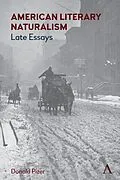The four initial essays in the "Specific Writers and Works" section display Pizer's critical style in its characteristic varied and incisive form. The initial essay, an exercise in cross-discipline analysis, discusses the ways specific works by Crane, Dreiser, and Steinbeck reveal their author's response to specific contemporary visual art works and reportage. The seconds offers a novel way of interpreting the naturalism of London' archetypal story "To Light a Fire" by pointing out the weaknesses in Lee Clark Mitchell's reading. The third centers on the usefulness of Norman Mailer's essay on American Naturalism not only in its refutation of Lionel Trilling's attack on the movement but in sharing with Trilling and others a misunderstanding of the central thrust of Theodore Dreiser's work. And the fourth is a close reading of Dos Passos over the course of three works of his experience of the 1931 Harland Coal Strike to clarify his thinking of the best means for the artist both to represent and participate in the struggle for social justice in America.
Autorentext
Pizer is one of the leading critics and historians of the significant late nineteenth- and early twentieth-century literary movement known as American naturalism.
Inhalt
Preface; Acknowledgments; Part I. General Essays; 1. American Naturalism: A Primer; 2. Critical Conceptions of American Realism and Naturalism, 1870-1970; Part II. Specific Writers and Works; 3. Naturalism and the Visual Arts: Dreiser, Crane, and Steinbeck; 4. Jack London's "To Build a Fire": How Not to Read Naturalist Fiction; 5. Norman Mailer, Theodore Dreiser, and the Politics of American Literary History; 6. John Dos Passos and Harlan: Three Variations on a Theme; 7. Theodore Dreiser's An American Tragedy and 1920s; Flapper Culture; 8. Dreiser's Relationships with Women; Part III. Donald Pizer and the Study of American Naturalism; 9. The Study of American Naturalism: A Personal Retrospective; 10. Stephen C. Brennan: Interview with Donald Pizer; Index.
